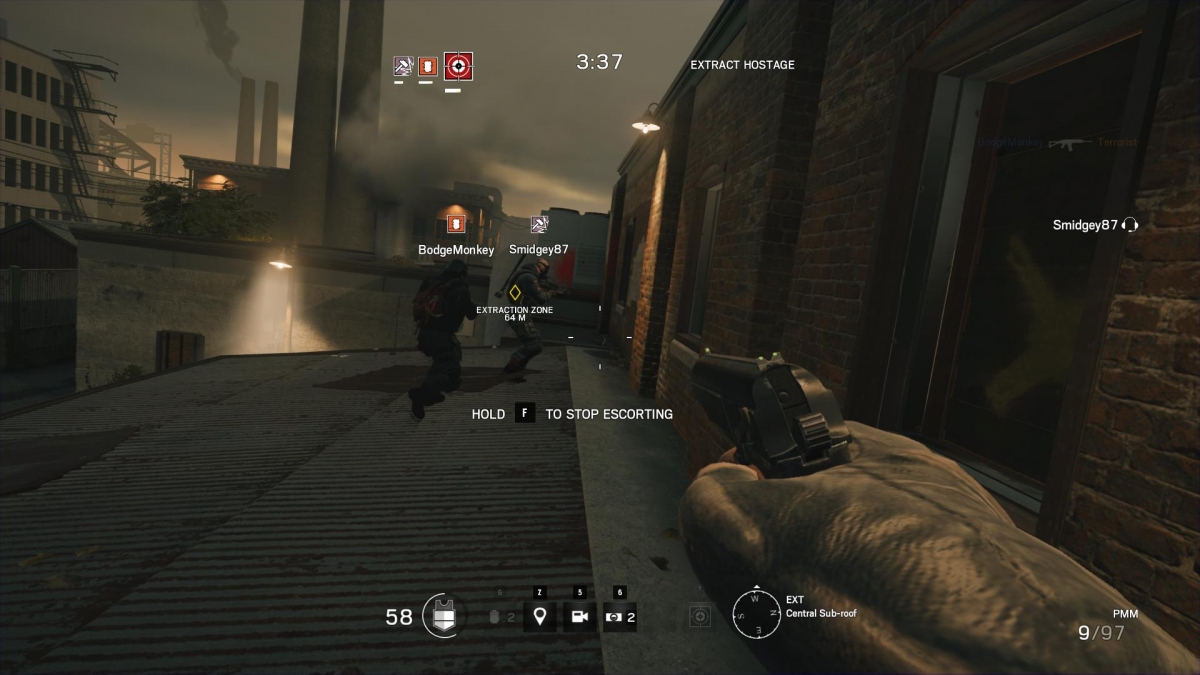Rainbow Six Siege review: Ubisoft's tactical shooter is back with a (flash)bang
Sledge has a sledgehammer. It's a sturdy thing, capable of bringing down brick walls and knocking holes in the floor. Whether he gave himself the ridiculous codename, was given it by the SAS, or adopted it upon joining the international counter terrorist force known as Rainbow, remains unknown.
Sledge is my favourite armed assailant in Rainbow Six Siege. A faux-Scottish warrior that makes the most of the game's new destruction system. It's a system I adore. Here the series has gone back to its roots, with maps often consisting of lone, largely-destructible buildings. You'll be rescuing hostages from planes, defusing bombs in large family homes and blasting holes in the floor of an embassy.
Environmental destruction is at the core of Rainbow Six Siege, with the combat built around it. Firefights occur at arm's length: full of panic, muzzle flash, and debris. Defending teams try to set up choke-points while attacking forces try to subvert them.
Which brings us back to Sledge. The game has a class system to keep things interesting, offering various Rainbow Six operators, each with different abilities to help with either assault or defence. There's the usual mix of trip mines, additional armour and medical abilities, but it's beyond that you get to the fun stuff. Toys include shock drones to stun attackers, a car battery to electrify metal walls, and a light machine gun capable of shredding everything before it in a hail of bullets.
Siege consists of two distinct core game modes. Terrorist Hunt is a cooperative challenge that pits you against AI terrorists hoping to prevent you from carrying out your mission, which might be to defuse a series of bombs or defend a hostage from waves of attackers. I've found this to be the most interesting part of the Siege package. The AI isn't the smartest but it is relentless, and you need clever teamwork to overcome them. A good plan and well-versed players should be enough to see you through, but it's a tense affair.




There are a couple of odd things in Terrorist Hunt that don't come off too well. The remotely activated slabs of C4 from the competitive online mode are instead proximity mines here, scattered around the level like... well, landmines. These are tucked away in drawers or behind cover and will often kill you cheaply. Cheap kills in the tactical shooter genre are always jarring, and this isn't even the worst culprit in the game. The suicide bomber enemies are both tonally confusing to the Rainbow Six series and annoying to take down, being able to resist several rounds to the head.
The regular adversarial mode is a little different. Defending teams try to fortify their objective while an attacking team tries to break in. Again, this could be a hostage or bomb site, but it's primarily a focus point for the defence to huddle around and try to weather the storm. The multiplayer game isn't really about shooting skills - you'll get most of your kills from out-thinking the other team. Coming at things from a new angle, both in terms of flanking your enemies or thinking of new strategies, will often reap rewards. Often games tip-toe on a knife edge, devolving quickly into a chaotic mess of detritus, bullet holes and bodies.
The systems underpinning Siege are complex, and learning how to best interact with them can be tough, but that's where the single player "Situations" come into play. The game caught a lot of flak for daring to launch without a single player campaign, but there is one, it's just that it's 11 short missions functioning mostly as tutorials for new players to grasp some of Siege's trickier concepts. Some of these missions prove quite a challenge, but completing them and the optional objectives contained within reaps rewards, and more than just a sense of accomplishment
Renown is the name of Siege's in-game experience point currency, and how it works presents my biggest annoyance with the game. Having to unlock Operators (and attachments for each of their independent guns) feels like an artificial gate to keep people playing. The cosmetic skins make sense, but the fact that each operator can only be picked once per team means that for players just starting out will often be left with the boring, vanilla Recruit operator type.
The game's 11 maps, paired with multiple objectives and layouts offers plenty. Much more than some critics of the game had been lead to believe before seeing the final product. Each map is playable at night and during the day, but the differing locations for objectives greatly shake up the approach and feel of each map.
It's a line trotting out a lot more recently, but if you have friends to play it with then Rainbow Six Siege feels like an essential purchase: a military shooter that doesn't so much break the mould as stick a breaching charge to it and blow it to pieces.
Rainbow Six Siege is the finest shooter of the year. Its systems combine to create a game that's immediately tense and feels several steps beyond what we've come to expect from yearly Call of Duty iterations. AAA games aren't usually this bold, but in this case the gamble has paid off. Rainbow Six Siege is sublime.
For all the latest video game news follow us on Twitter @IBTGamesUK.
© Copyright IBTimes 2025. All rights reserved.




















